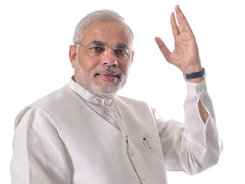The Indian economy accelerated in the first quarter (Apr-Jun period) at its fastest pace in two years. Consumer and corporate demand increased as confidence improved. A growing number of Indian citizens now believe the central bank and government are managing to steer the economy towards a faster pace of growth.
In the first quarter, Indian GDP expanded by 5.7% compared to the same quarter last year, according to figures published by the Central Statistics Office. This is a significant improvement on the 4.5% growth posted in the previous quarter.
A good start for Mr. Modi
India’s new Prime Minister, Narendra Modi, promised when he came into power four months ago that he would make it easier to do business through more efficient and faster clearance and stable tax policies.
Mr. Modi said much higher growth rates are required in order to make sure there are enough jobs for the tens of millions of young people who join the work force each year.
Since taking office, foreign capital inflows to India have increased significantly. Indian shares have performed better this year (+26%) than in any other country in Asia.

According to the financial journals in India, the latest strong GDP figures were mainly due to the steps taken by the previous government to bolster capital investment and boost consumer demand.
End of stagflation
Most economists in Asia, Europe and North America today who commented on the quarter’s growth believe the country is finally exiting a period of stagflation. Stagflation is a combination of weak GDP growth and rising prices – it comes from the words “stagnant” and “inflation”.
According to today’s figures, manufacturing, which had been holding back growth, increased by 3.5% during the quarter, compared to a -1.2% contraction in the same quarter last year.
Below is a list of how some components of the economy grew in Q1 2014-15 compared to Q1 2013-14. The figures in brackets are last year quarter’s rise/fall compared to the previous year:
- agriculture, forestry & fishing: 4% (3.8%),
- mining & quarrying: 2.1% (-3.9%),
- manufacturing: 3.5% (-1.2%),,
- electricity, gas & water supply: 10.2% (3.8%),
- construction: 4.8% (1.1%),
- trade, hotels, transport & communication: 2.8% (1.6%),
- financing, insurance, real estate & business services: 10.4% (12.9%),
- community, social & personal services: 9.1% (10.6%),
- GDP at factor cost: 5.7% (4.7%).
Bloomberg News quoted Prasanna Ananthasubramanian, chief economist at Mumbai-based ICICI Securities Primary Dealership, who said “There’s no doubt that this is the start of a recovery. A closer look reveals it is propped up by government spending. For sustained growth, it is crucial to get right the mix of industrial growth and its lagged impact on services.”
According to a report by The Conference Board last week, India’s Leading Economic Index was slightly down in July.
